Copyrights don’t last forever. Unless they are properly renewed, they eventually expire. And when they do, the works those copyrights protected fall permanently into the public domain, free for everyone to use without fear of infringement lawsuits.
Is this the case with some of the most beloved creations of the late children’s book author DR. SEUSS? Can you or I use the Sneetches or the Zaks in any way we’d like? If so, the ramifications in the current Star Trek/Dr. Seuss mash-up lawsuit (and beyond) could be staggering!
Okay, a brief recap of where we are. After getting sued for copyright infringement by Dr. Seuss Enterprises (DSE) for trying to mash-up Seuss drawings with Star Trek characters and calling their book Oh, the Places You’ll Boldly Go! (or “Boldly,” for short), publisher ComicMix, along with Tribbles creator DAVID GERROLD and artist TY TEMPLETON, appeared to have won. In March of 2019, Ninth Circuit Judge Hon. JANIS SAMMARTINO dismissed the case having found that Boldly qualified for protection under the doctrine of Fair Use.
So DSE appealed the ruling, and this past December, a 3-judge appellate panel of the Ninth Circuit unanimously agreed that Boldly was NOT Fair Use and sent the case back to Judge Sammartino’s courtroom with the understanding that Team Mash-up could no longer rely on a Fair Use defense to save their Lorax.
Things looked really bad for Team Mash-up, but just as I and many others were about to count out ComicMix and company, they seem to have pulled an ace from their sleeve. Well, actually, it’s somewhere between an ace and a “Hail Mary” pass late in the fourth quarter, but whatever it is, it could be a total game-changer!
Let’s dive in…
In their latest renwed motion for summary judgement (meaning, “Don’t even waste everyone’s time with a jury trial, Judge, ’cause you know we won, so just give us our money now…”) from this past Friday, DSE is asking for a statutory award of $75,000 per work infringed, and they are claiming that THREE Dr. Seuss books were “slavishly copied”—Oh, the Places You’ll Go! (“Go!”), How the Grinch Stole Christmas! (“Grinch”) and The Sneetches and Other Stories (“Sneetches”). Some examples are as follows…
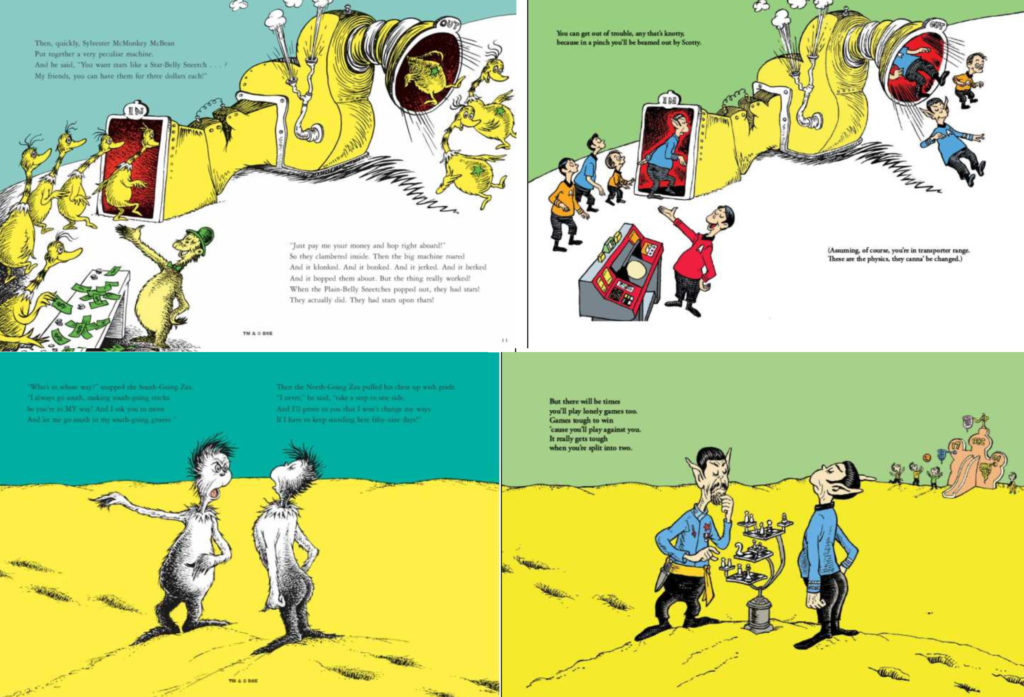
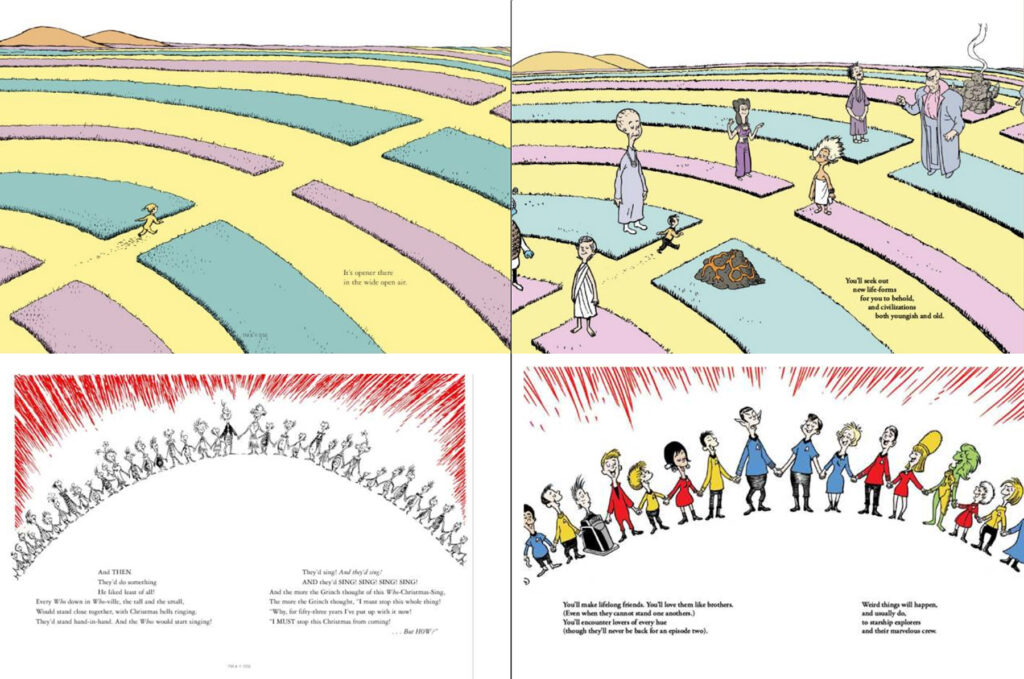
So that’s 3 x $75,000 = $225,000 in potential damages awarded to DSE that ComicMix would have to pay…and possibly attorneys fees, as well. Yeesh!
Now, before I tell you how Team Mash-up is planning to get out of this predicament, we need to go over two VERY important things…
SO YA WANNA SUE SOMEONE FOR COPYRIGHT INFRINGEMENT?
There’s a critical difference between a copyright and a registered copyright. When you create something—a poem, a book, a song, a painting, a photo, a blog entry—you automatically have a copyright for the work you created. You can use it as you like, license it, not license it, etc. But it’s yours and no one can say that you didn’t create it as long as you created a truly original work.
Now, let’s say that someone infringes on your copyright by reproducing all or part of what you created and then trying to sell or license their derivative (copied) work. Can you sue them? Well, yes and no. In order to sue someone and collect statutory damages if you win, you need to have a valid copyright REGISTRATION. It’s not too difficult to register your work with the U.S. Copyright Office. You can do it online for just $45 or via a four-page paper form (two of those pages are instructions) for a $125 processing fee.
The form isn’t Wocket Science, but it does need to be filled out properly and correctly. If you screw it up in some way—even by accident—it can cost you a lot! Don’t believe me? Take a look at this case where a fashion company called Unicolors won a huge $846,720 judgment for willful infringement against a much smaller company called Hennes & Mauritz, L.P. H&M appealed, arguing that that Unicolors‘ copyright registration was submitted improperly. They had actually argued this during trial, but the district judge felt that this clerical error was an honest mistake, and that without being able to prove an “intent to defraud” the Copyright Office, that it didn’t matter if the registration was filed incorrectly.
The three-judge appellate panel disagreed. They essentially said that a screw-up is a screw-up if done knowingly, even without some nefarious intent to defraud (which is almost impossible to prove anyway). And the instructions clearly explained how to fill out the form. So Unicolors “knowingly” provided false information. The appellate judges reversed the jury verdict, throwing out the $846K judgment, and tossed it back to the lower court, instructing them to ask the Copyright Registrar if this was a valid copyright. This appellate ruling came out just last year, and it’s really shaken things up! In fact, Unicolors is now asking the U.S. Supreme Court to review this ruling.
DR. SEUSS IN THE PUBLIC DOMAIN????
All right, now we have to back up in time from 2020 to 1953. Children’s book author THEODORE GEISEL, writing under the pen name Dr. Seuss, already had a small number of children’s books under his belt—including And to Think That I Saw It on Mulberry Street (1937), Horton Hatches the Egg (1940) and McElligot’s Pool (1947). But to give himself more exposure, Geisel sold some short stories to a magazine for young adults called Redbook. Among these stories were “The Sneetches” in July 1953 and “The Zaks” in March 1954…
The magazine publisher, McCall Corporation, registered copyrights for both issues and their contents. Geisel never bothered registering his own copyrights for those two stories, but in 1956, McCall assigned those copyrights to Geisel. So all is well and Dr. Seuss (and his estate DSE) now owns the rights to those two stories?
Well…
The Copyright Act of 1909 (still in effect in the1950’s) required a timely renewal of the copyright no later than 28 years after first publication to maintain ownership. That would have been 1981 and 1982. But Geisel never renewed his registration for those two stories. Does that mean they passed into the public domain??? Can anyone copy the “Sneetches” or “Zaks” without reprisal…from the folks at the estate of Theodore Geisel? (Sorry, I just needed to include at least one rhyme in this blog.)
Well…
Jump ahead (or back or whatever!) to 1961, and publisher Random House released The Sneetches and Other Stories as a book and obtained a copyright registration on behalf of Geisel in 1962. So Seuss DOES still have the copyright, then?
Well… (Okay, I’ll stop)
Back in 1962, the instructions for Line 5 of the copyright application form explained to filers: “If any substantial part of this work has been previously published, give a brief general statement of the new matter in this version. New matter may consist of compilation, translation, abridgment, editorial revision, and the like, as well as additional text or pictorial matter.” Random House left Line 5 empty…even though two of the four stories in Sneetches, “The Sneetches” and “The Zax,” (originally “The Zaks”) incorporated elements of, and are based on, the stories initially published in Redbook’s July 1953 and March 1954 issues.
The Copyright Office isn’t expected to play detective and research every application, so they took Random House at their word and issued a copyright registration for Sneetches, even though it omitted any reference to the Redbook originals.
In 1989, 28 years later, Geisel’s Random House agent applied to renew the copyright registration on Sneetches, and again the “Contribution to Periodical or Composite Work” line was left blank, failing to disclose that two of the four stories derived from work previously published in Redbook.
And before you start thinking that this was just a case of Geisel and/or Random House not knowing that the Copyright Office expected disclosure of previously-published work, his applications to register the copyright in Yertle the Turtle and Other Stories in 1958, and to renew it in 1986, disclosed that Redbook had published earlier versions of its stories.
Now, it’s actually Team Mash-up’s contention that—regardless of everything else that came later—the rights to Sneetches and Zaks (in their original form from Redbook) fell into the public domain in 1981 and 82 because that original copyright was never properly renewed 28 years after the first publication. If ComicMix wanted to, they could take the artwork and text for those two stories, change nothing, package them, and sell them in bookstores…and DSE couldn’t do anything to stop them since DSE doesn’t hold those rights any more than you or I do. Public domain is public domain.
Okay, jumping over to 1975, and Geisel created an image “The economic situation clarified: A prognostic re-evaluation,” which was first published (along with a Seuss poem titled “Uppers & Downers”) in the June 15, 1975 issue of The New York Times Magazine. Fifteen years later, that same illustration was copied (literally photocopied) by Geisel, altered slightly to add a little boy character, and reused as part of the last of his books to be published during Geisel’s lifetime: Oh, the Places You’ll Go! The original cartoon from 1975 is shown on the left below, and the corresponding page from Go! is on the right…
The New York Times Magazine obtained a copyright registration for that issue in 1975 and renewed it in 2003. When Random House applied to register the Go! copyright in 1990 on behalf of Geisel and his wife Audrey, once again Line 5 of the application form—“Identify any preexisting work or works that this work is based on or incorporates”—was left blank.
WHY ARE YOU BEING SO DARN PICKY???
These are all just minor clerical errors, right? I mean, it’s obvious that Dr. Seuss wrote all those books, drew all those pictures, owned all the copyrights, and left them all to his estate.
Well, the courts might feel differently.
So why did Team Mash-up wait until now to bring all this up, you ask? Shouldn’t they have raised these questions back in 2017 or 2018 or 2019 when motions were still being filed with Judge Sammartino?
Actually, they did. They filed motions under Section 411 of the Copyright Act, which says that you can’t sue someone for infringement until you have a proper copyright registration, and if there’s any question of whether it’s a proper registration, the court must check with the Registrar of Copyrights to confirm it’s valid. But here, Judge Sammartino just assumed. She determined that the amount of material that Geisel incorporated into Sneetches and Go! from previous sources wasn’t a substantial enough part of either book to necessitate disclosing it on a copyright registration form. She made that determination (without consulting the U.S. Copyright Office) back in 2018.
But then the 2020 appellate ruling came down in that Unicolors lawsuit that I mentioned earlier…and that literally changed everything about this case. In their appellate ruling, the three judges said that the courts could NOT simply assume. Judge Sammartino HAD to ask the Registrar of Copyrights for an answer to the question: knowing what you now know about the previous publication of part of these works, would you have accepted or rejected this application for copyright registration? And if the answer is that the application would have been rejected and sent back for correction, then the current copyright registration must be assumed to be invalid.
SO WHAT HAPPENS NOW?
Back in 2018, Judge Sammartino didn’t have any existing caselaw requiring her to contact the Registrar of Copyrights. Now she really has no choice. And this isn’t that onerous a request to make of the Registrar, and such answers are usually provided within 30 days at most.
But THEN what happens?
Well, here’s where it becomes a chess game again. Y’see, there’s two possible answers that the Registrar could come back with. Let’s assume she voids the registrations for both Sneetches and Go! Then the only potential item of infringement remaining is that one drawing of everyone holding hands across the world…the one image from Grinch…
Is one lone image, featuring none of the same characters and not even the same number of characters, enough to constitute infringement? Suddenly, the question of Fair Use is back on the table! The appeals judges ruled Boldly was not Fair Use back when most of it was “slavishly copied.” Now it’s just one page. Does that still qualify as infringement, or are we back into Fair Use territory for using de minimis (that least amount necessary) of copyrighted material to create an original new work?
Obviously, that would be the “best case scenario” for Team Mash-up. But what happens if the Registrar says that this was just a little “oopsie” and not enough to invalidate the copyright registrations? After all, for Go!, there was only ONE illustration copied from a previous publication in The New York Times Magazine…just one in a whole, big book. What does one little illustration matter?
Indeed! What DOES one, little illustration matter? In fact, Boldly used only one, little illustration from Grinch…and they didn’t copy that one nearly as thoroughly as Geisel copied his illustration for The New York Times Magazine. And remember that THEY own the copyright for that issue (which includes Geisel’s art piece), as they never assigned those rights back to Geisel. And The New York Times Magazine had a circulation of more that 2 million at the time.
So if one little illustration copyrighted by another publisher with a circulation of 2 million isn’t enough to bother the Copyright Office, then why should it bother the court enough to award a $75,000 judgment against ComicMix for doing essentially the same thing…even less than the same thing?
Oh, and then let’s talk about The Sneetches and Other Stories, which uses more than just one page of artwork but TWO FULL STORIES published first in Redbook. If THAT isn’t enough to bother the Copyright Office, then why should DSE get tens or hundreds of thousands of dollars from ComicMix if that sort of thing doesn’t really bother them when the shoe is on the other foot?
So, yes, there does seem to be a lot of this chess game left to play. The first order of business is to see what the Registrar of Copyrights has to say, and I suspect that’s going to happen, as the ruling in the Unicolors case kinda requires it. And even though Unicolors is trying to appeal to the Supreme Court, there’s no guarantee that the High Court will even agree to hear the case, and until they provide an opinion, the ruling from the Ninth Circuit Court of Appeals remains applicable law. And so Judge Sammartino is going to have to rule on Team Mash-up’s latest 411 Motion long before anyone hears from the Supreme Court.
And that means, for now, we’re all going to have to wait to hear from Judge Sammartino and—most probably after that—from the Registrar of Copyrights.
If you’d like to read all of the above in a much drier, much longer 21-page legal motion without all the fun cartoons, here’s the DEFENDANTS’ MOTION FOR RECONSIDERATION OF ORDER DENYING MOTION FOR ISSUANCE OF REQUEST TO THE REGISTER OF COPYRIGHTS PURSUANT TO 17 U.S.C. § 411(b) that Team Mash-up filed with the court this past Friday.
The next court hearing is scheduled for June 10, folks. Stay tuned!

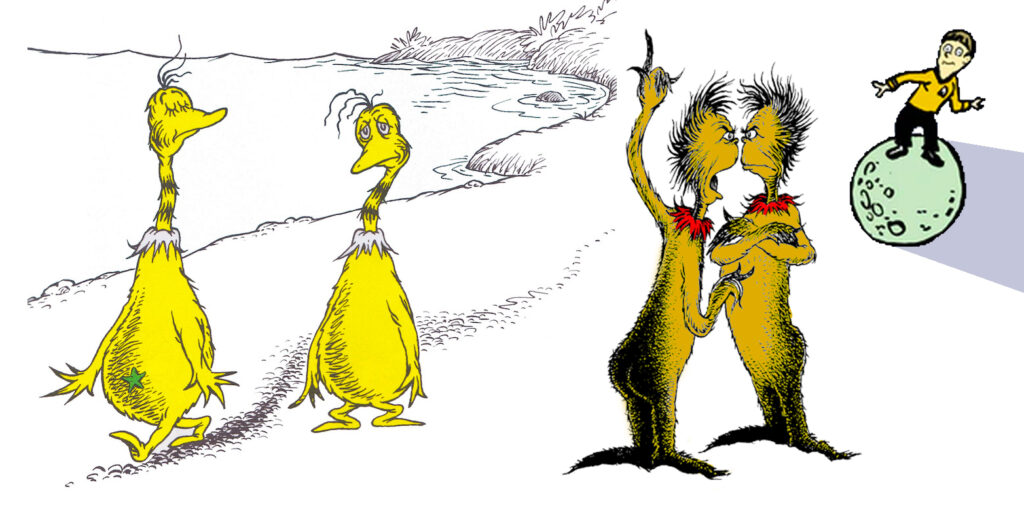
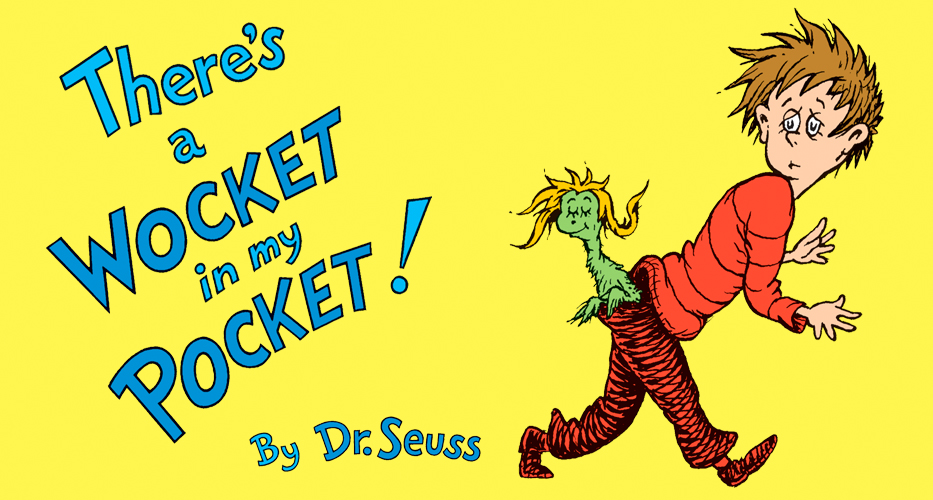
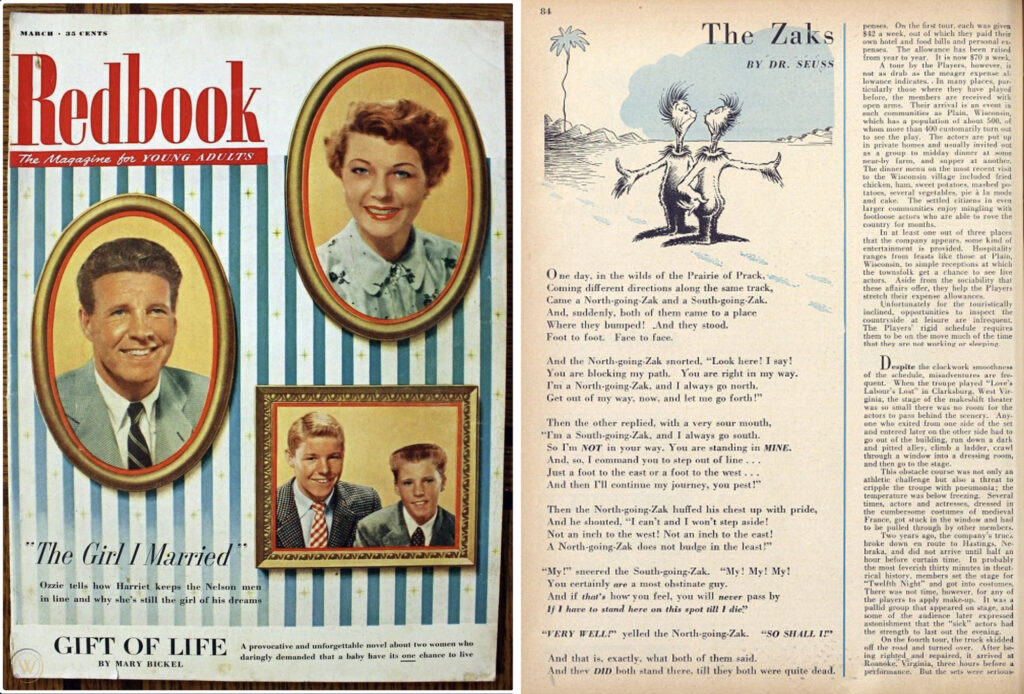
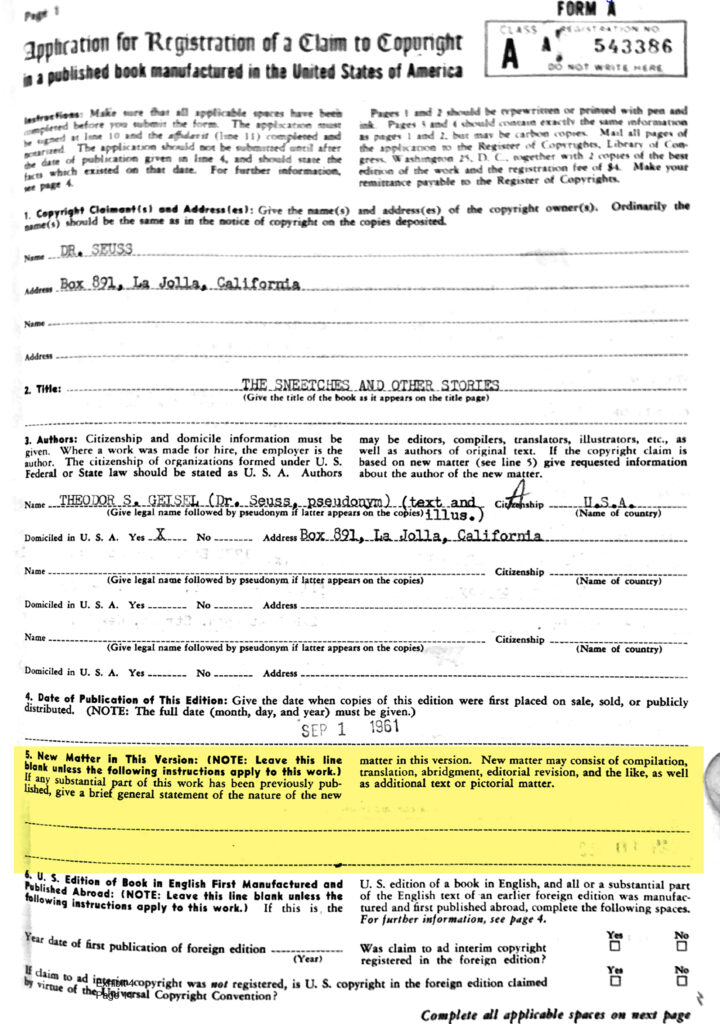
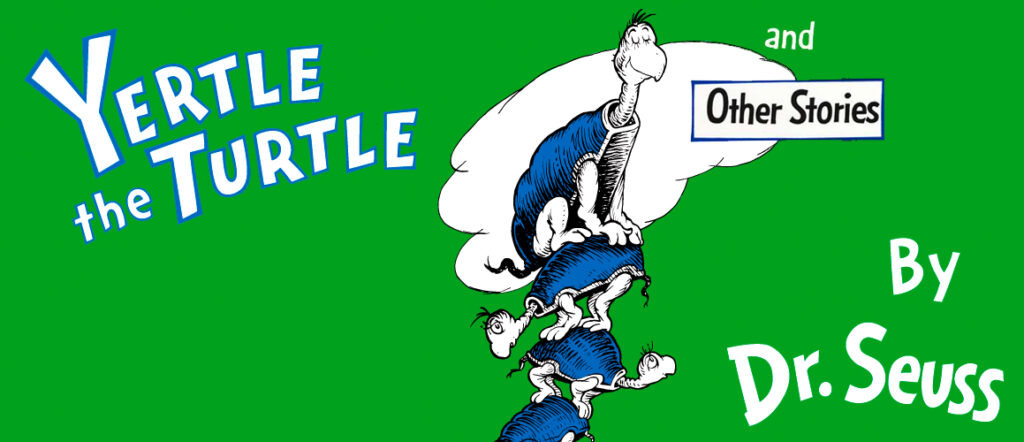
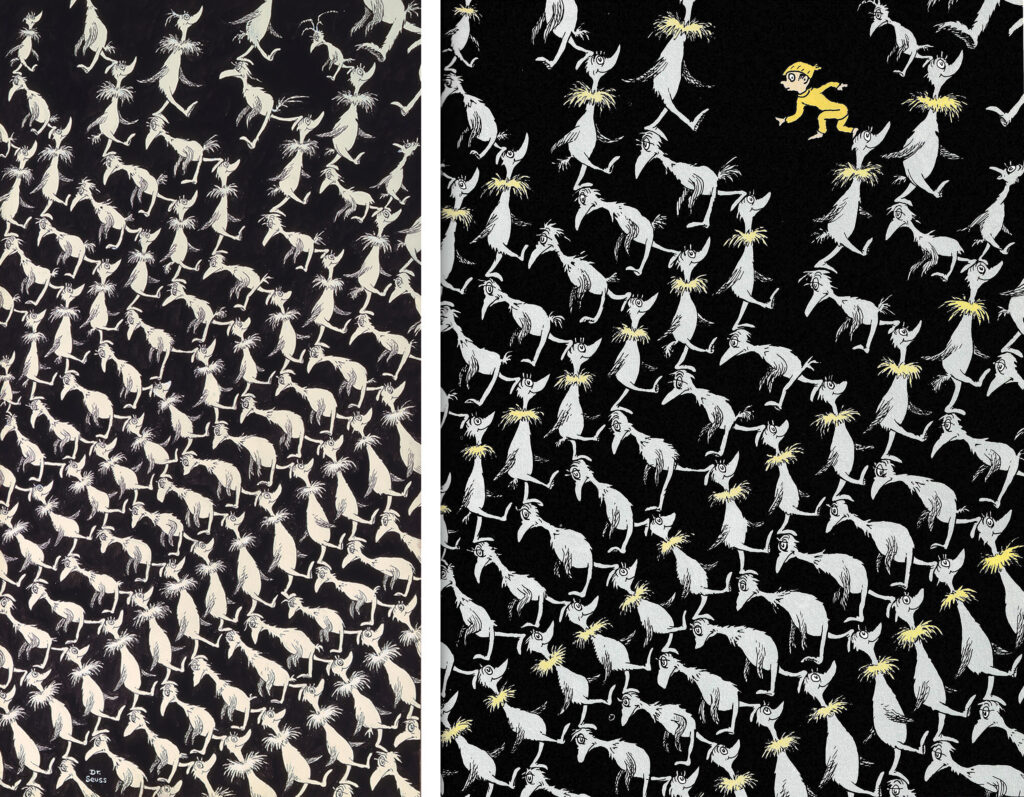
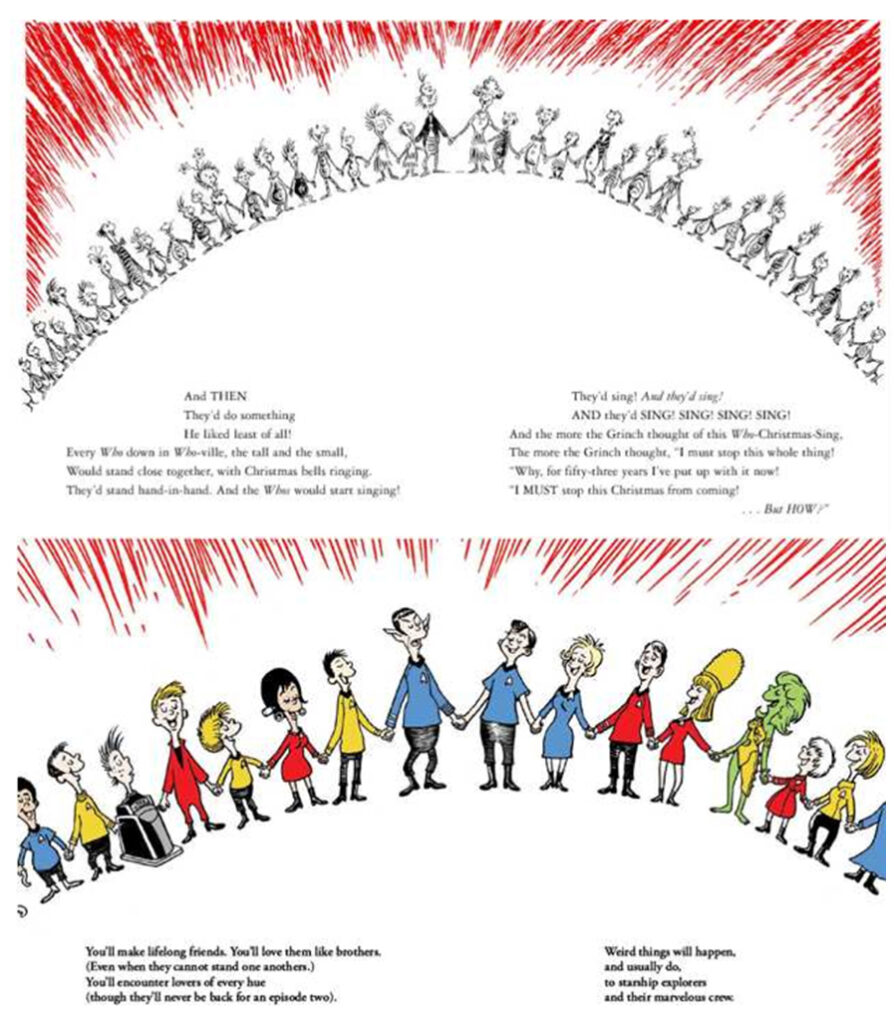
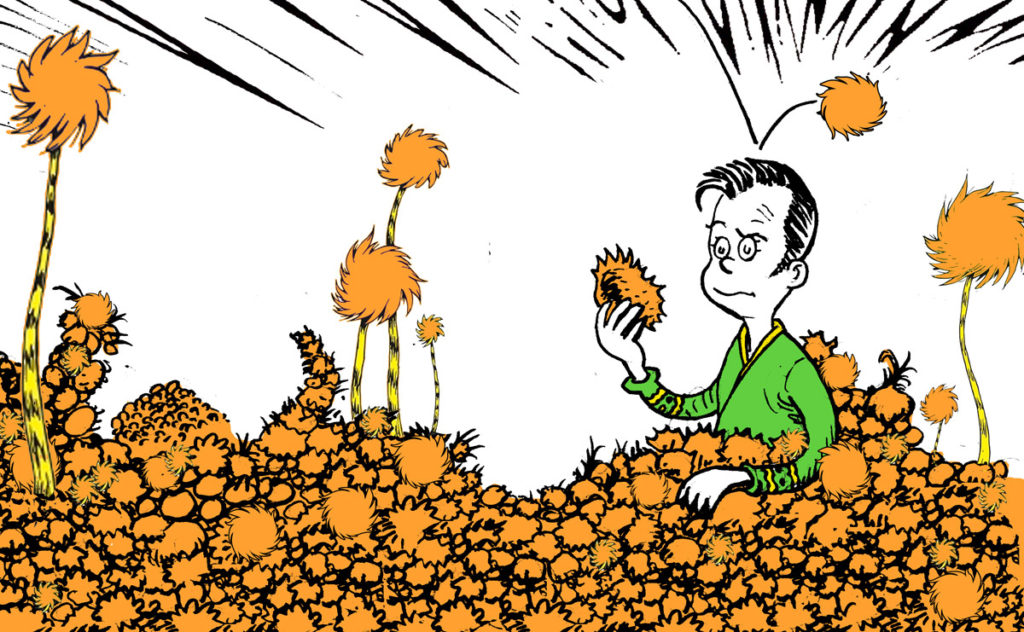
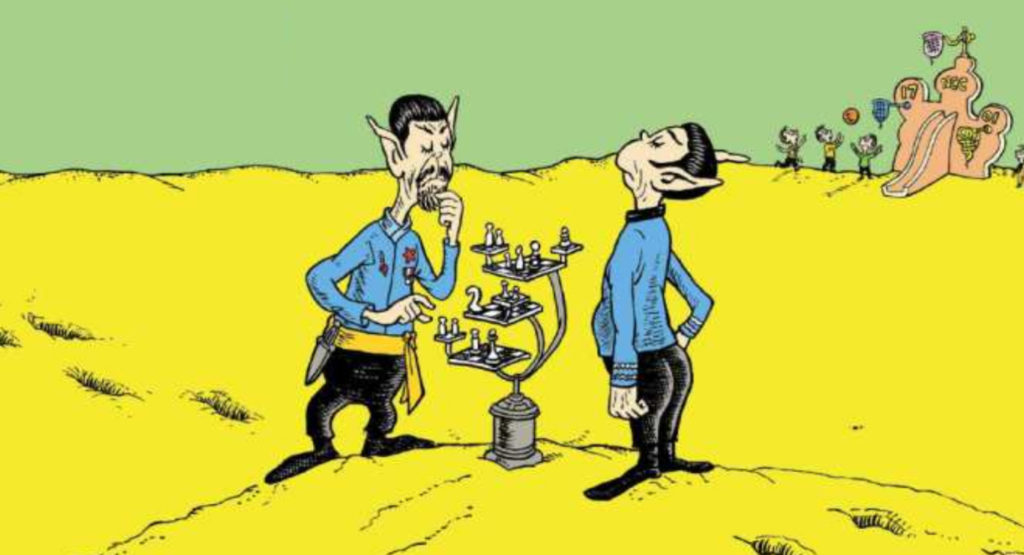
Thanks for the update, I’d been wondering about this.
Amazing! In that final image, I only see the red thing above the people holding hands as similar. Surely people holding hands doesn’t exist as a copyrightable thing, it appears everywhere, from Mattise, to environmental groups, to religious groups, it appears everywhere!
Yep.
“Good grief, Charlie Brown” I’m sure that’s a (c) quote.
I’m sure whatever the judge rules, the followup will be yet another set of appeals.
Maybe I’ll live just long enough to see this settled.
Depending on what happens, there could be more appeals. But as time goes on and more rulings come in, the likelihood of those appeals being accepted for judicial review decreases.
well, what about Roddenberrys cppyright? they are infringing by using a likeness of Spock.
That’s hard to say. It’s much easier to characterize Boldly as an honest parody of Star Trek than it is to characterize it as a parody of Dr. Seuss. I think any attempt by CBS to go after ComicMix for infringement would have a much greater chance of winding up with a summary judgment of Fair Use than it did with DSE. Also, considering that the first publication of many of these images was back in late 2016, CBS might have already waited past the statute of limitations, which is four years.
Damn the man down with Dr. Seuss.
Dr. Seuss died in 1991, Shane. He’s already as down as he can get.
To quote many people, although I think that Benny Hill said it best:
“Never ASSUME. ‘Assume’ makes an ‘ass’ out of yo’u’ and ‘me’.”
I resisted the urge to quote the contemporary wisdom. 🙂
This is simply brilliant research on behalf of the defendants – finding flaws in the copyright registrations.
There’s enough evidence this will clearly show neglect on the part of DSE and (PENGUIN) RANDOM HOUSE.
It will all come down to The Registrar of Copyrights having to give legal option to the missing information their predecessor did not catch. This will have legal ramifications for other cases.
All very possible. A lot will come down to what the Registrar determines. But at least for Team Mash-up, they have strategies to play this no matter which way the answer to the copyright question comes down.